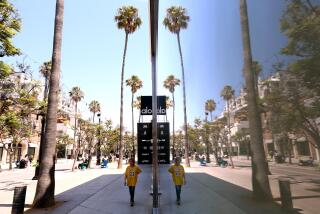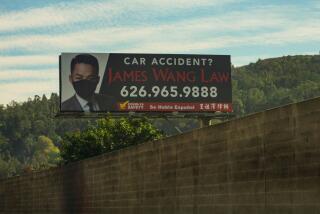Billboard Sign Swap Considered : Advertising: Company proposes tearing down 27 old signs on city streets in exchange for right to put up 10 new--and larger--billboards along freeways.
POMONA — A decades-old battle will be renewed Monday night when the City Council considers a sign company’s proposal to tear down half of the city’s old billboards and put up new ones along area freeways.
In return for the right to erect 10 new signs along the freeways, Regency Outdoor Advertising Inc. would tear down 27 signs on Mission Boulevard and Holt, Garey, Park and Towne avenues. Regency officials say the plan would improve the city’s appearance by replacing the old signs with modern displays.
Billboard opponents counter that the plan would destroy scenic views and hurt the city’s image.
A public hearing on the proposal will begin at 7 p.m. Monday in the Council Chambers at City Hall.
J. Keith Stephens, Regency’s real estate manager, said the plan is a good solution to the long-running controversy. He said Regency has carefully selected its proposed freeway sign locations to minimize the environmental impact.
*
Six of the billboards would be placed along the Orange Freeway (57), where businesses--including the Shilo Inn, gas stations and restaurants--already have large signs. Two would face the Pomona Freeway (60) east of Reservoir Street, and two would be placed on the Corona Expressway (71), south of the Pomona Freeway. All would be in industrial zones, as city code requires.
“I don’t think we’re going to do any visual harm to the city,” Stephens said.
Regency has reached an agreement with Patrick Media Group Inc. to buy 27 of its billboards in Pomona and tear them down. Stephens said this would eliminate two-thirds of such ads in the central city area.
Stephens said Regency has also agreed to refrain from using the new billboards to advertise tobacco or hard liquor. The company would pay the city $5,000 for each new billboard, a $500 annual fee per billboard and $250 every time the advertising is changed.
Robert Jackson, one of a group of residents who have circulated petitions and flyers opposing the proposal, said the revenue would not compensate for the damage done to the city.
Jackson said motorists along the Orange Freeway enjoy sweeping panoramic views that would be ruined by billboards.
“We don’t need to have these huge eyesores,” he said.
The old billboards that Regency would remove are “just about worthless” anyway, Jackson said, and the city should be able to force their removal without cluttering freeway corridors.
But Melody Peterson, another resident opposed to billboards, said she thinks the Regency proposal is a starting point for discussion, offering a potential solution to a longtime city dilemma: how to force sign companies to take down unsightly billboards without paying them compensation.
Billboards have been a political issue in Pomona since the early 1960s, when residents became concerned about their proliferation. In 1964, the City Council adopted an ordinance banning billboards outside industrial zones and gave sign companies two years to remove them.
*
The removal period was subsequently lengthened, and although some signs were removed, the issue has never been resolved. Pomona now has more than 50 billboards, many of them in commercial zones, and sign companies have refused to remove any of them unless they receive compensation.
The Regency proposal would allow the company to put up freeway signs as large as 872 square feet, much larger than the signs that would be torn down.
M. Margo Wheeler, community development director, said the result would be a net increase of nearly 7,000 square feet of billboard signage. Wheeler has recommended that the city reject the proposal, but she said that if the council favors the plan, it should at least limit the new billboards to no more than 400 square feet each.
Stephens said the size limit and other restrictions proposed by Wheeler are financially unfeasible.
“I think the recommendations were designed to kill the deal,” he said.
More to Read
Sign up for Essential California
The most important California stories and recommendations in your inbox every morning.
You may occasionally receive promotional content from the Los Angeles Times.










